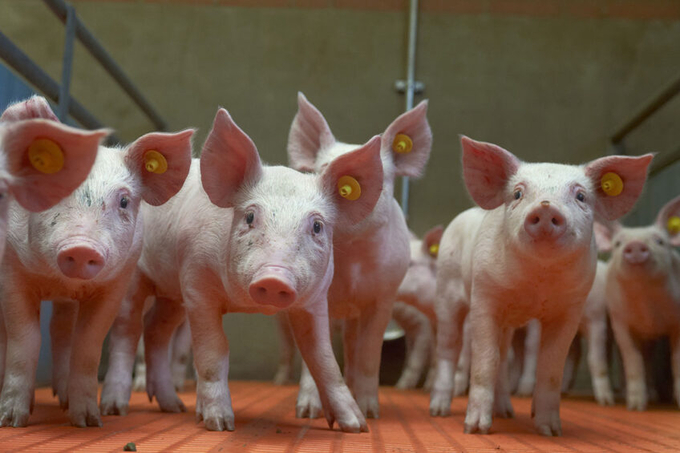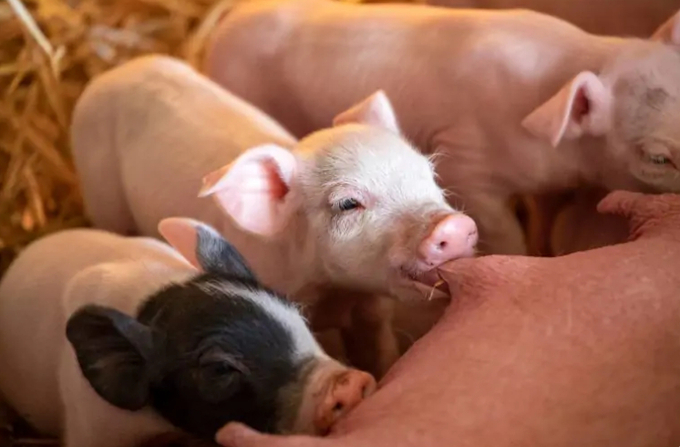- Read all
- Rice
- Fisheries
- Cassava
- Fertilizer & Pesticide
- Coffee
- Animal Feed
- Cocoa
- Seed
- Tea
- Wood
- Pepper
- Agricultural Cooperations
- Cashew
- Agricultural Investments
- Rubber
- Governmental Policies
- Sugarcane
- Agricultural Startup Ecosystem
- Corn
- Technological Innovations
- Spices
- Organic Agriculture
- Bean
- Food Manufacturing
- Fruit & Vegetable
- Agricultural Value Chain
- Flower
- Water & Waste Management
- Meat
- Processed Food
- Dairy
- Plant Originated Products
- General Agro Commodities
- Animal Originated Products
Some tips to reduce mortality in piglets
August 19, 2022

Piglets after weaning. Photo: Van Assendelft Fotografie
According to statistics in recent years, the average piglet mortality in the world ranges from 15% to as high as 20%. The causes of piglet mortality include a multitude of complex issues between the sow, the piglet, and the environment.
The viability of piglets is a key determinant of the productivity and profitability of the entire production system. Therefore, it is necessary for producers to find strategies to reduce piglet mortality both before and after the weaning period.
First, understanding the natural behavior of the show, especially around farrowing and the physiology of the newborn piglet is essential for improving piglet survival.
Because newborn piglets do not have the ability to regulate their own body temperature and are very susceptible to hypothermia, which can lead to risks, piglets tend to snuggle up to the mother pig to find a source of heat and close to the mother's udder. This makes them vulnerable to the mother pig pressing down every time the sow stands up or lies down. In modern intensive production systems, 50% of piglet mortality before weaning occurs within the first 3 days after farrowing due to low vigor and tolerance to the new environment.
The second is to choose the body's resistance or immunity. Accordingly, increasing the number of piglets in farrowing sows often leads to lower piglet birth weights and more complex diseases that reduce survival. Therefore, the selection of immune traits is related to the livestock production characteristics of each farm and economic purposes. It is, therefore, necessary for breeders to have specific knowledge of the genetic underpinnings of the immune system in order to have useful insights into its possible incorporation into breeding programs.
Third, it's important to keep an eye on suckling piglets: As litter sizes increase, pig farmers need to ensure that newborn piglets receive enough colostrum. Therefore, it is necessary to temporarily separate the piglets who have already consumed all their colostrum from their mothers on the first day, so they do not have to compete with others.
This step should be applied based on the birth order or birth weight of the whole flock. In the birth order approach, newborn piglets are approached with sows, and then they are separated to make room for later or low birth weight piglets an additional opportunity to breastfeed.

For most pig breeds, the average number of piglets per litter is about seven or eight which is nice. Photo: Poutry World
Fourth: Apply cross-training method
The goal of cross-feeding is to ensure a balanced population of pigs that benefit from nutrition while providing them with the best possible chance of survival. In this method, piglets are taken out of their farrowing nests from the very beginning. They are then taken to "feeding" milk from another sow of the same lactation but with fewer calves to improve access to more milk. These piglets will continue to live with the “new mother pig” until weaning.
However, farmers must ensure that newborn piglets are not transferred too early, and will miss colostrum, or too late as this may adversely affect and decrease growth rate.
Thursday: Piglet temperature management
During the first few hours after birth, it is considered a very important time to maintain the body temperature of piglets and improve their survival rate. Low birth weight piglets often have a slower average daily weight gain and therefore need additional heat after birth.
It is recommended that farmers keep the house temperature at 25 degrees Celsius when the mother pig starts to bite the nest. After that, it is necessary to adjust the temperature to 20 degrees Celsius after the last piglet of the litter is released.
The application of the aforementioned heat is usually extended for the first 12 hours after farrowing, by using radiant heat, underfloor temperature regulation, and piglet drying combined with the use of heating lamps and straw in the barn for maximum efficiency as well as to improve the first milking time.
Final note: All the measures just described above are necessary management tools to improve the survival rate of piglets. However, their implementation depends on the practical knowledge as well as husbandry skills of each livestock household and region in the reproductive stage. Therefore, trained and experienced breeders are crucial to improve animal welfare, minimize stress and avoid undue impact on piglets.
Source: Kim Long - nongnghiep.vn
Related news
-
ASEAN cooperates on digitalization in aid of rural development
In rural regions, digitalization and technological innovation present both benefits and obstacles.September 5, 2022 -
Newspaper print number 211, out today October 24, 2022
News of agriculture, farmers and rural areas featured in Vietnam Agriculture newspaper No. 211 today 24/10/2022.October 24, 2022 -
Farmers develop economic from a seedless fruit
Bao Lam seedless persimmon brings high economic efficiency to the people and is a famous specialty fruit with its distinctive flavor of Lang Son province.October 19, 2022 -
Farmers overcome the 'supplies price storm' with the No. 7 Hana rice variety
In the summer-autumn crop of 2022, the price of materials has increased. However, thanks to the production associated with the enterprise, along with the good harvest of Hana No. 7 rice variety, farmers have overcome difficulties.August 29, 2022 -
Macadamia: ‘Supernumerary actor’ becomes ‘the main role’
From intercropping and planting to cover bare land, macadamia in Dak Lak has now asserted itself as the main source of income for many families.August 26, 2022
Events See more

Vietnamplas 2022 - Vietnam International Plastic and Rubber Industry Exhibition
23-03-2023 - 26-11-2022 09:00 - 17:00
Saigon Exhibition and Convention Center (SECC) – 799 Nguyen Van Linh Boulevard, District 7, City. Ho Chi Minh.

GROWTECH EXPO - FLORAPLANTEXPO 2021
02 - 05-11-2022 09:00 - 17:00
Saigon Exhibition and Convention Center (SECC) – 799 Nguyen Van Linh Boulevard, District 7, City. Ho Chi Minh.

VTG 2022
18 - 25-10-2022 09:00 - 17:00
Saigon Exhibition and Convention Center (SECC) – 799 Nguyen Van Linh Boulevard, District 7, City. Ho Chi Minh.

VIETSTOCK 2022 - SPECIALISED EXHIBITION OF LIVESTOCK, FEED AND MEAT PROCESSING IN VIETNAM
12 - 14-10-2022 08:00 - 17:00
799 Nguyen Van Linh, Tan Phu Ward, Dist. 7, Hochiminh City, Vietnam

VTG 2022
21 - 27-09-2022 09:00 - 17:00
Saigon Exhibition and Convention Center (SECC) – 799 Nguyen Van Linh Boulevard, District 7, City. Ho Chi Minh.
.png)
VIETFISH 2022
22 - 26-08-2022 09:00 - 17:00
Saigon Exhibition and Convention Center (SECC) – 799 Nguyen Van Linh Boulevard, District 7, City. Ho Chi Minh.
Business Opportunities See more
-
BURANI INTERFOOD is looking for Buyers in Vietnam
Type:
November 22, 2021
-
BURANI INTERFOOD is looking for Buyers in Vietnam
Type: Wholesaling Meat
November 22, 2021
-
BURANI INTERFOOD is looking for Buyers in Vietnam
Type: Wholesaling Meat
November 22, 2021
-
BURANI INTERFOOD is looking for Buyers in Vietnam
Type: Wholesaling Meat
November 19, 2021
-
BURANI INTERFOOD is looking for Buyers in Vietnam
Type:
November 19, 2021
-
Indian purchaser looking for high quality cashew nut kernel from Vietnam
Type: Exporting Cashew
Mar 14, 2016
534
Limitless database of qualified and verified agricultural partners
124
Exclusive buy & sell leads on specific agricultural commodities
24
Agricultural events in Vietnam and Asia Pacific region
Stay informed!
Enter your email address below to receive updates each time we publishes new content
